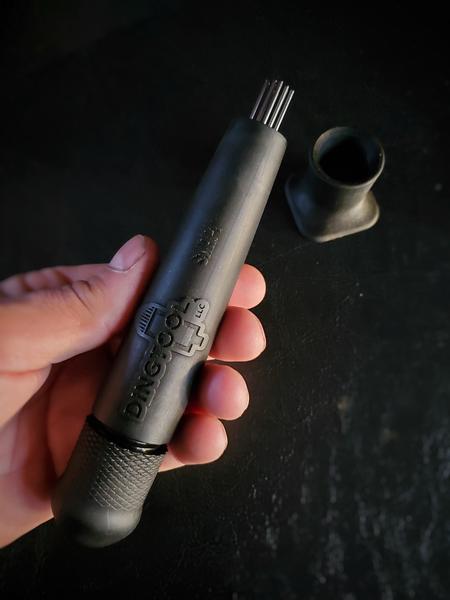Ding Tool, a South Dakota-based paintless dent repair (PDR) tool manufacturer, has launched a new range of 3D printed automotive dent repair tools, in collaboration with SLA/DLP 3D printing specialist B9Creations.
PDR is a method of removing minor dents from the body of a motor vehicle. Ding Tool’s new PDR tools are patent pending, and were unveiled at SEMA, an automotive specialty products trade event taking place in Las Vegas from 5 to 8 November.
Manufactured using B9Creations’ 3D printing and materials, the new tools leverage a proprietary process that offers a significant advantage over traditional PDR techniques with increased dent repair speed. “Even if this tool is given to a new technician, they’ll gain a 20 percent to 30 percent increase in speed,” explains Duane Langenfeld, Ding Tool Founder.
“I fixed 10 dents in a roof in 30 seconds with these 3D printed tools, moving seamlessly from prototype to final production units.”

Updating paintless dent repair techniques using 3D printing
Common PDR techniques utilize a metal rod, or body pick, to push out dents from the underside of a vehicle body panel. Since its invention in 1960, the PDR tool industry has relied on this limiting technique that only provides a single point of contact with the vehicle.
Duane Langenfeld, based in Rapid City, South Dakota, has been repairing vehicles utilizing PDR since 1994. With extensive experience in the industry, Langenfeld recognized the lack of efficiency in PDR tools. Seeking a solution for his PDR shop that could potentially provide a higher throughput, Langenfeld developed his own process that provided more points of contact with the vehicle, and founded Ding Tool in 2018 to take his idea from concept to tool production.
To help rapid prototype Langenfeld’s tool ideas, Ding Tool partnered with local South Dakota-based B9Creations, manufacturer of the B9 Core Series of DLP 3D Printers. Since initially collaborating with the firm, Lagenfeld has been able to convert his design to prototype and end-use production in a short amount of time. The end-use PDR tools are produced from B9Creations’ Rugged – Nylon 6 material, released by the company in February 2019. Part of B9Creations’ engineering resin line, the material is said to be equivalent to injection-molded nylon, and is designed for functional testing and low- to mid-volume production runs.
The end result is a durable 3D printed PDR tool that, using Ding Tool’s proprietary technology, is able to provide up to 19 contacts with a dent, increasing the repair speed. It also allows users to fine-tune the amount of spring-loaded force delivered when repairing dents. “Using B9Creations Rugged – Nylon 6 engineering material, these functional end-use tools hold up to repeated hammering, taking out dents without leaving scars on the paint or the metal,” added Langenfeld.
Material developments from B9Creations
Alongside the launch of the Rugged-Nylon 6, B9Creations has also introduced a new high-detail design resin this year, named the HD Slate. Geared towards molding and model making, the resin is optimized for surface finish and creating detailed parts, with 20 μm slice thickness.
Recently, B9Creations also partnered with SDC Technologies, California-based coating specialists, to open a $500,000 additive manufacturing materials development lab, located at B9Creations’ Rapid City headquarters.
The company also plans to launch a suite of biocompatible materials for use with its newly released B9 Core Med 500 3D printer, targeting the medical industry. Thus far, two biocompatible materials have been released from the range. The new medical 3D printer and materials were launched in conjunction with the company’s new additive manufacturing Healthcare Division & Service Bureau.
Subscribe to the 3D Printing Industry newsletter for the latest news in additive manufacturing. You can also stay connected by following us on Twitter and liking us on Facebook.
Looking for a career in additive manufacturing? Visit 3D Printing Jobs for a selection of roles in the industry.
Featured image shows 3D printed “Snap!” PDR tool. Photo via Ding Tool.
